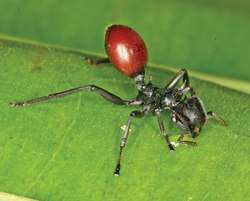Myrmeconema neotropicum
Myrmeconema neotropicum is a tetradonematid nematode parasite.
| Myrmeconema neotropicum | |
|---|---|
 | |
| Cephalotes atratus ant infected with Myrmeconema neotropicum showing swollen red abdomen | |
| Scientific classification | |
| Kingdom: | |
| Phylum: | |
| Class: | |
| Subclass: | |
| Order: | |
| Family: | |
| Genus: | Myrmeconema |
| Species: | M. neotropicum |
| Binomial name | |
| Myrmeconema neotropicum Poinar & Yanoviak, 2008 | |
Myrmeconema neotropicum is a new genus and species of parasitic tetradonematid nematode that apparently induces fruit mimicry in the tropical ant. Presently the only known host species is Cephalotes atratus, a South American ant with a black abdomen. Upon infection, the gaster, or bulbous hindmost region of the abdomen, resembles one of the many red berries found in tropical forest canopies.
Life cycle
Myrmeconema neotropicum's life cycle begins when a bird eats the infected ant. Upon passing through the birds digestive system the eggs are defecated out. The eggs are then picked up by the ants and fed to their larvae. Once inside the immature ant gut the eggs migrate to the gaster where they will fully mature.
Once the ant larvae pupate the mature nematodes begin to reproduce inside of the gaster. The males expire soon after mating but the females hold the eggs within themselves. Once the ant develops into a young adult the gaster begins to become translucent, thus allowing the red embryos to be seen. The longer the ant is parasitized the redder the gaster becomes.
The infected ant then travels outside now mimicking small red berries which are a favorite food of birds. The ant is confused for a berry and is eaten by the bird starting the whole cycle over again.
Although bird predation on an infected Cephalotes atratus has not yet been observed, the combination of field experiments and the known natural history of the ant indicate that this is the most parsimonious explanation for transmission of the parasite to new ant colonies.
Signs and symptoms
Infected ants develop bright red gasters, tend to be more sluggish, and walk with their gasters in a conspicuous elevated position. According to Jonathan (2011), infected gasters had 57% more mass, but 37% lower metabolic rates, compared to uninfected gasters. These changes likely cause frugivorous birds to mistake the infected ants for berries and eat them. Increased reddening coincides with a shift in ant behavior that includes foraging outside the nest, thus increasing the probability of consumption by a duped bird.
Morphology
Female Myrmeconema neotropicum mature within the gaster of the host ants. They are about 1 mm in length and about 112 μm at their greatest width. Males are smaller than females (680 μm in length and 97 μm in diameter) (Poinar & Yanoviak 2008). The infected young adult ant is completely black and spends most of its time tending brood within the nest. As the parasite embryos develop within the eggs, the ant gaster becomes translucent, ultimately appearing bright red.
References
- Poinar, George; Stephen P. Yanoviak (February 2008). "Myrmeconema neotropicum n g, n sp, a new tetradonematid nematode parasitising South American populations of Cephalotes atratus (Hymenoptera: Formicidae), with the discovery of an apparent parasite–induced host morph". Systematic Parasitology. 69 (2): 145–153. doi:10.1007/s11230-007-9125-3. PMID 18038201.
- Sanders, Robert (2008-01-16). "Ant parasite turns host into ripe red berry, biologists discover". UC Berkeley NewsCenter.
- Yanoviak, S. P., M. Kaspari, R. Dudley, G. Poinar Jr. 2008. Parasite-induced fruit mimicry in a tropical canopy ant. The American Naturalist 171:4, 536–544.
- Jonathan Z. Shik, Michael Kaspari, and Stephen P. Yanoviak (2011). Preliminary Assessment of Metabolic Costs of the Nematode Myrmeconema neotropicum on its Host, the Tropical Ant Cephalotes atratus. Journal of Parasitology: October 2011, Vol. 97, No. 5, pp. 958–959.
- Evans, C. (2015, February 5). Parasitic Mind Control. Retrieved from http://www.sciencenutshell.com/parasitic-mind-controlmyrmeconema-neotropicum/